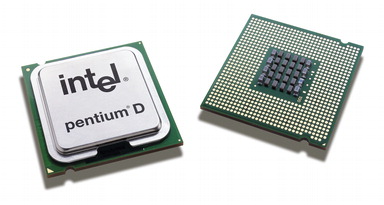Intel D 840 Dual Core CPU
14. Conclusion
With the new Dual-Core series from both Intel and AMD, a new era in processors has started. They are already available at varying speeds as well as prices. It is rather interesting to put them to the test and compare them against the single core generation of processors to see what performance is like and whether it is worth moving up this new generation of CPU. We all knew that the Extreme Edition Pentium at 3.73Ghz was the fastest CPU from Intel and for this reason we chose to compare it with the D 840, also from Intel.
A head to head of the D 840 with an AMD Dual-Core would also be very interesting and it is something we are planning to do in the near future.
The overall performance of the D 840 is very good. Although the CPU is supposed to be better in multiprocessing, and of course it is, we also liked its performance with single processes. Our CPU benchmarks, especially SiSoft Sandra 2005, PCMark and PassMark, reported extremely high scores for the D 840 which indicates how fast the specific CPU is. In game environments, the D 840 might not be as fast as the 3.73GHz ED but believe us, it won't let you down. Instead, you will be able to play your favorite games while at the same time encode your movies in the background without any significant performance drop.
Something which also impressed us was the framerate that the CPU produced during DVD Shrink's Deep Analysis and off course the very fast times for the full encoding. One thing that is noticeable though, is that the performance of the the D 840 differs from application to application and while it may be ideal for multi-threaded applications, we got the feeling that most applications don't currently take advantage of this feature. Perhaps when dual core processors are more common place, applications will follow suit.

The temperature levels were rather high, as they were with the ED series, but this time they were even higher. At idle state, the CPU reported 54°C but during our tests, with the default FSB frequency, when running our benchmarks the temperature reached 71°C. Perhaps a better cooler would make things better. For testing the CPU with higher FSB frequencies, we had to set the CPU temperature level in our monitoring software higher, in order to avoid the continuous temperature alert dialog box.
If you like overclocking, the D 840 is for you. The CPU can run without problems and with the stock cooling system in place, up to 3.85GHz instead of the default 3.2GHz. We also managed to get the CPU up to 4.00GHz and although Windows started normally, when we ran the PCMark tests, we saw the blue screen. It maybe that the 77°C core temperature was responsible for this and a better cooling system would allow for even higher speeds.
The D 840 costs around US$550 on the e-market. The respective prices for AMD's 4200+ Dual-Core are US$490 while the 4600+ close to US$700. We believe that the price is reasonable given the overall performance but we would like to wait before giving a final judgement until we have reviewed the rival CPU from AMD.






















